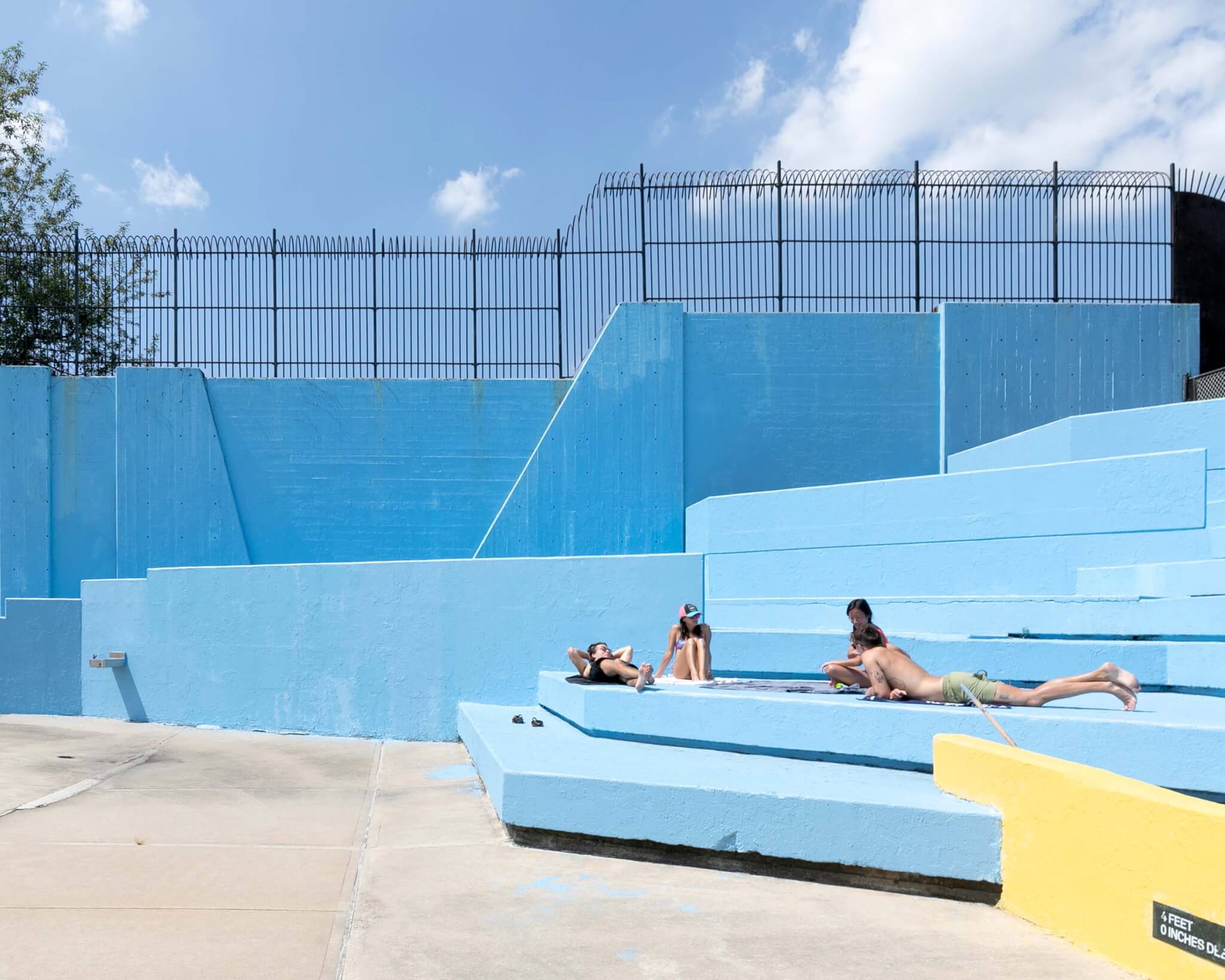For a certain sect of swimming enthusiasts in New York City, the start of September brings the yearly lament: Why should our outdoor public pools close while it’s still so hot outside? In Public Pools, a long-running research project by architect Karolina Czeczek and photographer Anna Morgowicz that was recently on view at Citygroup, the duo took the question one step further. They asked: Why should the pools close at all?
There are 52 public outdoor pools in New York City, each open from the end of June to the start of September, in accordance with the closing and reopening of the city’s public schools. Beyond the documentation of existing pools through drawings and Morgowicz’s photographs, Czeczek imagined various uses for New York’s various pool typologies that might extend their use beyond this summer season.
One of the more practical proposals repurposes smaller “vest pocket pools” by simply covering them with an inflatable roof. Built during Mayor John Lindsay’s administration to serve dense communities, these uniformly sized and shaped pools were meant to be arranged in different ways, depending on the area in which they were placed. Many have since been modernized as “Cool Pools,” a 2017 initiative that brought in bright colors, fun seating, and tropical plants, creating a resort-like feel. It’s an atmosphere one could easily see a neighborhood running to in the cold days of January, should an inflatable heat structure come into play.
Concepts like a public laundromat in the Metropolitan Pool recreation center in Brooklyn, which is already indoors and open year-round, feel less likely to be realized. The idea is meant to recall New York’s public pools’ original use—public bathing. Perhaps the heat produced by the laundromats might make more sense in conjunction with the exhibition’s plan for the uniformly 40-foot-by-20-foot-by-3-foot pool volume established by Lindsay, so-called minipools, which the designers reimagine as saunas in the winter months.
For the famed Works Progress Administration (WPA) pools, Czeczek envisions the stadium seating surrounding the pools as the perfect setting for events. The idea recalls McCarren Park Pool: Built in 1936, the monumental art moderne–style pool closed in 1984 and was held in limbo until two decades later, when events company JellyNYC saw an opportunity to transform the emptied pool into a music venue for hipsters. But residents of the quickly gentrifying Williamsburg seemed to realize that its original recreational use was far more valuable, so the pool was restored and reopened in 2012.

One only has to look through photographs from McCarren Pool’s time as a free-to-the-public music venue to see the fatal flaw of such repurposing: These massive pools require constant upkeep and maintenance, acts of repair that necessitate an offseason. Each year, the parks department spends weeks revitalizing pools to prepare for reopening. This consists of annual repainting and repairs in addition to any larger jobs. Even during our shortened season these larger pools suffer from lifeguard shortages and struggle to open in their entirety. Pools of any size can be shut down for days to weeks by any number of mishaps.
Still, the question persists: Why are pools only open ten weeks a year? The city’s answer is simple: Our pools are most populated by children, who go back to school after Labor Day. Parents adjust their own schedules and often replace lazy afternoons with extracurricular activities. During these shoulder seasons, the pools would be too empty to justify the extra cost. Without children, adults simply don’t go enough.

New York needs a deeper cultural shift for there to be enough demand for a longer pool season. To put it bluntly: We need more disgruntled swimmers clamoring for aquatic improvements. Czeczek and Morgowicz’s deft speculative interventions propose how design can help facilitate new cultural attitudes around how we think about and use public pools, but in advance of real implementation, there are steps that the New York parks department can take toward making these spaces not only more useful but welcoming and delightful as well.
Throughout their history, New York City’s public pools have often served a backdrop for the city’s politics. Take, for example, the WPA pools in the 1930s, which Robert Moses wielded as an instrument to reinforce urban segregation. Today, this racist legacy continues in contemporary forms such as the parks department’s strict pool policies—which are notorious for unfair regulations and surveillance, particularly among Black swimmers.

One way to induce demand for pools to remain open longer is to create spaces that are beloved rather than just a means of beating the heat. A public pool ought to welcome a wider range of natators, like parents with kids burdened by after-school gear or childless young adults on a budget eager to find a free fun activity. It will likely take years of joyful, diverse, good experiences to replace the decades of closures and disrepair that have plagued our public pools. Czeczek and Morgowicz’s research highlights a need that goes well sated in other world-class cities: public swimming facilities that are popular destinations, not last resorts.
Lily Puckett is a writer based in New York City.
→ Continue reading at The Architect's Newspaper
